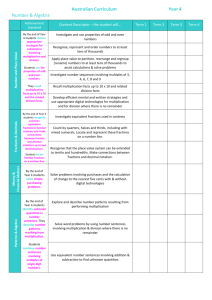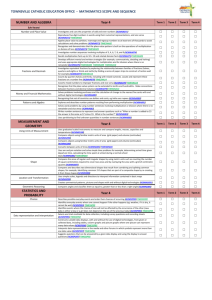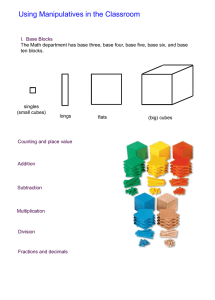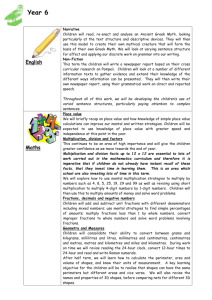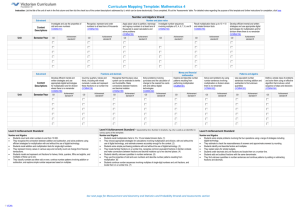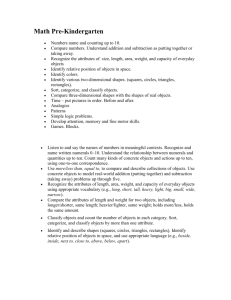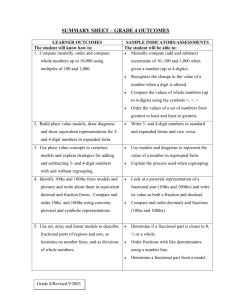Scope and Sequence Tools – Year 4
advertisement
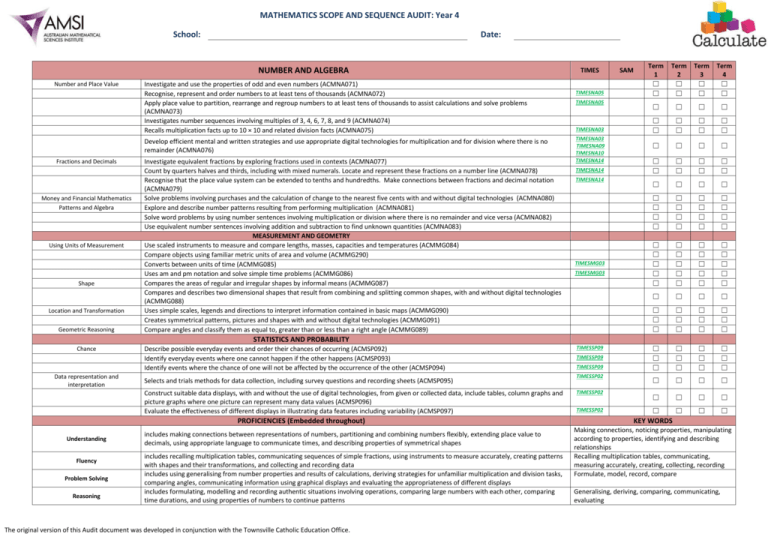
MATHEMATICS SCOPE AND SEQUENCE AUDIT: Year 4 School: Date: NUMBER AND ALGEBRA Number and Place Value Investigate and use the properties of odd and even numbers (ACMNA071) Recognise, represent and order numbers to at least tens of thousands (ACMNA072) Apply place value to partition, rearrange and regroup numbers to at least tens of thousands to assist calculations and solve problems (ACMNA073) Investigates number sequences involving multiples of 3, 4, 6, 7, 8, and 9 (ACMNA074) Recalls multiplication facts up to 10 × 10 and related division facts (ACMNA075) Develop efficient mental and written strategies and use appropriate digital technologies for multiplication and for division where there is no remainder (ACMNA076) Fractions and Decimals Money and Financial Mathematics Patterns and Algebra Using Units of Measurement Shape Location and Transformation Geometric Reasoning Investigate equivalent fractions by exploring fractions used in contexts (ACMNA077) Count by quarters halves and thirds, including with mixed numerals. Locate and represent these fractions on a number line (ACMNA078) Recognise that the place value system can be extended to tenths and hundredths. Make connections between fractions and decimal notation (ACMNA079) Solve problems involving purchases and the calculation of change to the nearest five cents with and without digital technologies (ACMNA080) Explore and describe number patterns resulting from performing multiplication (ACMNA081) Solve word problems by using number sentences involving multiplication or division where there is no remainder and vice versa (ACMNA082) Use equivalent number sentences involving addition and subtraction to find unknown quantities (ACMNA083) MEASUREMENT AND GEOMETRY Use scaled instruments to measure and compare lengths, masses, capacities and temperatures (ACMMG084) Compare objects using familiar metric units of area and volume (ACMMG290) Converts between units of time (ACMMG085) Uses am and pm notation and solve simple time problems (ACMMG086) Compares the areas of regular and irregular shapes by informal means (ACMMG087) Compares and describes two dimensional shapes that result from combining and splitting common shapes, with and without digital technologies (ACMMG088) Uses simple scales, legends and directions to interpret information contained in basic maps (ACMMG090) Creates symmetrical patterns, pictures and shapes with and without digital technologies (ACMMG091) Compare angles and classify them as equal to, greater than or less than a right angle (ACMMG089) TIMES TIMESNA05 TIMESNA05 TIMESNA03 TIMESNA03 TIMESNA09 TIMESNA10 TIMESNA14 TIMESNA14 TIMESNA14 TIMESMG03 TIMESMG03 SAM Term 1 ☐ ☐ Term 2 ☐ ☐ Term 3 ☐ ☐ Term 4 ☐ ☐ ☐ ☐ ☐ ☐ ☐ ☐ ☐ ☐ ☐ ☐ ☐ ☐ ☐ ☐ ☐ ☐ ☐ ☐ ☐ ☐ ☐ ☐ ☐ ☐ ☐ ☐ ☐ ☐ ☐ ☐ ☐ ☐ ☐ ☐ ☐ ☐ ☐ ☐ ☐ ☐ ☐ ☐ ☐ ☐ ☐ ☐ ☐ ☐ ☐ ☐ ☐ ☐ ☐ ☐ ☐ ☐ ☐ ☐ ☐ ☐ ☐ ☐ ☐ ☐ ☐ ☐ ☐ ☐ ☐ ☐ ☐ ☐ ☐ ☐ ☐ ☐ ☐ ☐ ☐ ☐ ☐ ☐ ☐ ☐ ☐ ☐ ☐ ☐ ☐ ☐ ☐ ☐ ☐ ☐ ☐ ☐ ☐ ☐ ☐ ☐ ☐ ☐ ☐ ☐ STATISTICS AND PROBABILITY Chance Data representation and interpretation Describe possible everyday events and order their chances of occurring (ACMSP092) Identify everyday events where one cannot happen if the other happens (ACMSP093) Identify events where the chance of one will not be affected by the occurrence of the other (ACMSP094) Selects and trials methods for data collection, including survey questions and recording sheets (ACMSP095) Construct suitable data displays, with and without the use of digital technologies, from given or collected data, include tables, column graphs and picture graphs where one picture can represent many data values (ACMSP096) Evaluate the effectiveness of different displays in illustrating data features including variability (ACMSP097) PROFICIENCIES (Embedded throughout) Understanding Fluency Problem Solving Reasoning includes making connections between representations of numbers, partitioning and combining numbers flexibly, extending place value to decimals, using appropriate language to communicate times, and describing properties of symmetrical shapes includes recalling multiplication tables, communicating sequences of simple fractions, using instruments to measure accurately, creating patterns with shapes and their transformations, and collecting and recording data includes using generalising from number properties and results of calculations, deriving strategies for unfamiliar multiplication and division tasks, comparing angles, communicating information using graphical displays and evaluating the appropriateness of different displays includes formulating, modelling and recording authentic situations involving operations, comparing large numbers with each other, comparing time durations, and using properties of numbers to continue patterns The original version of this Audit document was developed in conjunction with the Townsville Catholic Education Office. TIMESSP09 TIMESSP09 TIMESSP09 TIMESSP02 TIMESSP02 TIMESSP02 KEY WORDS Making connections, noticing properties, manipulating according to properties, identifying and describing relationships Recalling multiplication tables, communicating, measuring accurately, creating, collecting, recording Formulate, model, record, compare Generalising, deriving, comparing, communicating, evaluating

